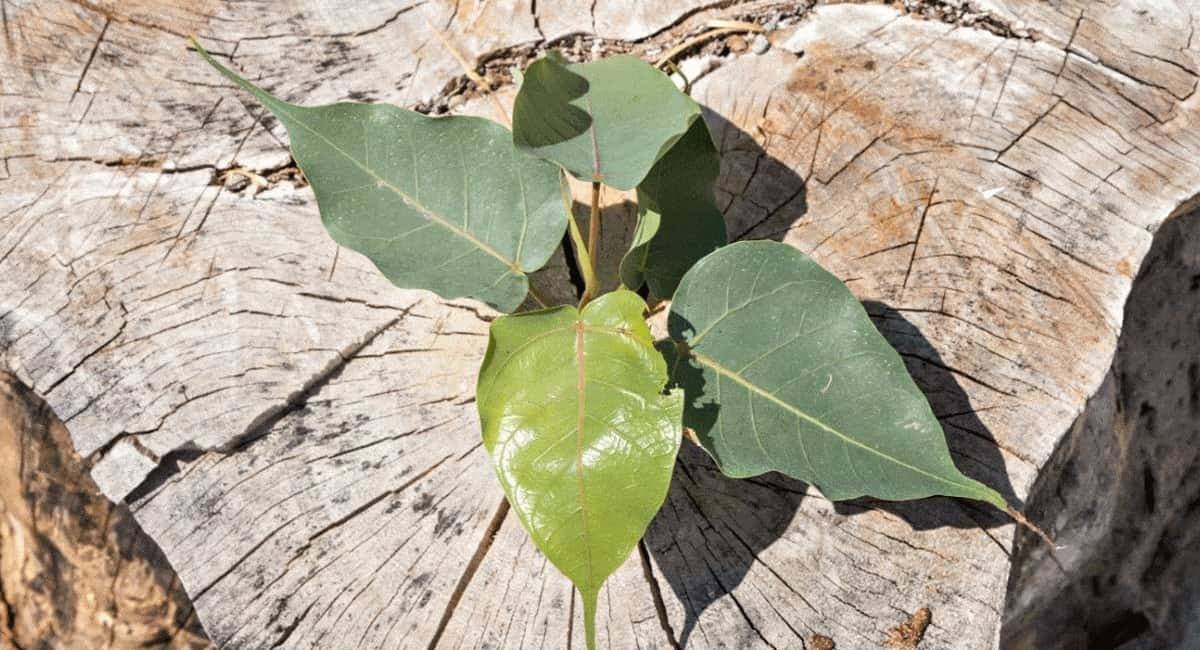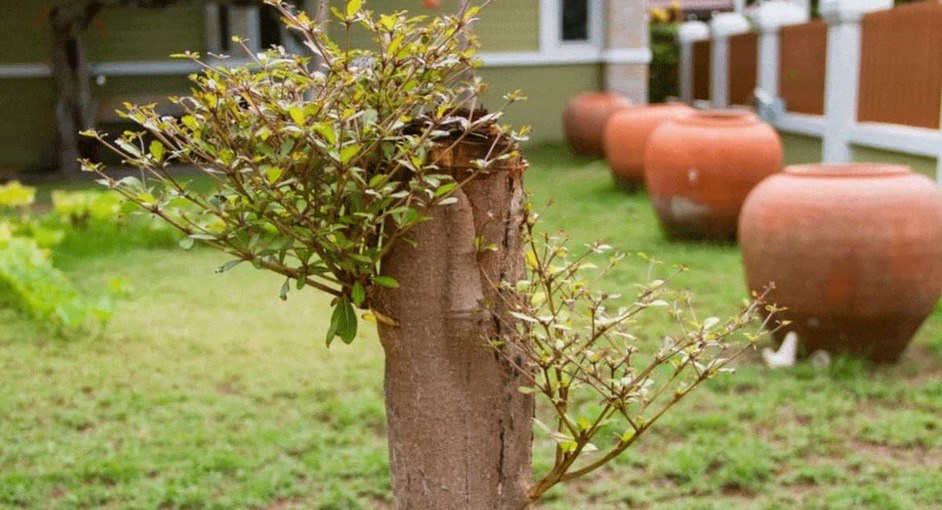How to Stop Tree Sprouts From a Stump With 4 Methods
A tree stump is what is leftover of a tree after it has been felled or cut. It is the part of the trunk with the roots still remaining in the ground. This tree stump can be used to generate wood or for coppicing, which is the process of cutting down a tree to a stump to regrow it.
If it isn’t your aim to regrow a tree from its stump, it is important you completely destroy it. This is because usually after thirty days, the tree starts sprouting. This can become a problem because once they've started growing, they can be quite a headache to manage.
Therefore, we’ve explored four different methods in this guide to show you how to stop tree sprouts from a stump with four different methods.
Why Should You Get Rid of Tree Stumps?
After your tree has been cut (which can be a huge inconvenience) you think all's well and your problems have been solved, but as long as the roots to your stump are still in the ground, this is far from being true. There are reasons why you should get rid of the root of the stump immediately after the tree has been cut. These reasons include:
Causes of Tree Stumps Sprouting

Tree stumps have the ability to regenerate into new trees. A tree that has been recently cut can re-sprout around the root or the edge of the stump. This often occurs in deciduous trees, which are trees that shed their leaves seasonally – mostly during fall. Examples of these types of trees include:
The cut part of the trunk can introduce disease into the new trees forming, or if properly looked after, it can become a strong tree that can be used for timber. But what causes a tree stump to sprout?
1. Normal Regenerative Biology
The main reason why a tree stump will sprout is due to a regenerative mechanism that is completely normal and natural. This is done as a mechanism to regenerate plants. This is how a tree prevents itself from dying after it's been cut. A deciduous tree stump will deliberately sprout to lengthen the lifespan of the tree.
It does this through the root where energy is stored and produced in photosynthesis. This is then used for growth from the stump. If this is not what you want your tree stump to do, then it must be fixed.
The new sprouts growing from the root don't have a high probability of becoming a big tree because of the lack of a strong foundation but will rather look like a tree branch. As non-threatening as this sounds, they can still develop into a full zombie tree.
2. The Presence of Tree Suckers
A term usually related to stumps sprouting is tree suckers. They are new sprouts that grow mostly from the root of a tree. They naturally appear after a tree has been through something strenuous like being cut down.
The presence of suckers will make a tree sprout again, especially in fruit trees and others. These tree suckers do have the ability to develop into a tree. You can't just yank them away as a way to solve the problem because they'll just grow again. The best way to manage tree suckers is to prevent them from growing.
How to Stop Tree Sprouts From a Stump
There is more than one way to kill a stump that's sprouting, so if one method doesn't work for you, try one of the other methods.
1. Stump-killing herbicide
This is one effective method of getting rid of the sprouting stump. This is a chemical that contains herbicides that can be applied in two different ways: spray-on and brush-on.
This chemical stump remover is more efficient if you apply it thirty minutes after cutting the tree. This way, you don't even give the stump a chance to sprout in the first place. If you do this during the spring, the higher the chance that the herbicide will be more effective.
Chemical herbicide should be applied while using safety gloves and other protective clothing to prevent any injury. Apply the herbicide according to instructions. Be careful during this process because some herbicides can be fatal to fresh soil and nearby plants.
Herbicide prevents the growth of plants by going through the stump and poisoning the roots. The stump can still sprout even after doing this because the root is deep in the ground and impossible to reach. You can drill a hole in the stump to get more reach. When the stump begins sprouting, just apply the chemical to it. This method can also be referred to as the cut and paint method.
2. Stump grinder
Compared to all the other methods we will discuss, this one is the most expensive. Therefore, people steer clear from it, although it is as effective as the rest. You will also have to be careful while using the stump grinder. Make sure you know what you're doing and understand the controls. Your protective gear should be ready at hand and include some headphones because stump grinders are very loud. Wear goggles before you start cutting because there will be pieces of wood flying around.
This method will require you to be patient and spend most of your time performing a good job. To reduce the amount of work you have to do, use a chainsaw to cut the stump until it is closer to the ground. This will make the process much easier.
This method is mostly used for bigger tree stumps. So if you're using a stump grinder for one, be cautious.
After you've gotten to the root and have had everything cleared out, fill the ground with fresh soil to make the ground level.
3. Use Epsom salt
This is one quick technique to stop stump sprouts. Make a hole in the stump using a drill, then add the Epsom salt and some water. Do this consistently to make sure it's effective in completely destroying the stump.
4. Burn the stump
This is another method you should approach with caution. If possible, you should hire an expert. The chances of an accident happening is very high, especially if you don't know what you're doing.
Start by making a few holes about ten inches deep in the stump with a drill. Then put some potassium nitrate (KNO3) in the hole followed by some hot water (use protective gloves), which will dissolve the potassium nitrate and then distribute it evenly.
The pieces of wood you dug out while drilling the holes will come in handy now. Place them in the holes, then light them on fire. They will begin to burn. Do not let the fire out of your sight. After everything has turned to ash, use a shovel to remove it.
In some cases, especially in the past, people would blow the stump away to get rid of it. However, this method is now frowned upon. You will still need to consult with your local authorities if you can actually burn anything yourself. In some places, this is prohibited because of the unpredictability of fires. Doing this can warrant a fine or serious punishment, especially if it goes wrong.
How to Repurpose Your Cut Tree Stumps for Home Decor
So you've cut your stump from the root and have no idea what to do with it. Don't throw it away – you can use it to make something or for aesthetic and decorative purposes. But before you do this, you need to give it some care.
1. Wipe the top of the stump
Do this with a wet cloth to clean all the wood debris and dirt off. Do not wipe the bark – just the top. Make sure the bark is smooth and there is no wood sticking out.
2. Use a planer to smooth
The planer is going to smooth the top of the stump evenly with its flat surface. After that, clean the top then use sandpaper to make the surface more even.
3. Wipe off
Clean the top with a damp cloth. If you've also smoothed and used the sandpaper on the bottom of the stump, clean it too.
4. Protect the bark
Use a sealer to spray the bark to prevent it from falling off. Apply from top to bottom then all around. Place it in a safe and dry spot outside to dry overnight. After that, feel free to decorate your home with it.
Conclusion
Leaving tree stumps outside can be not only a danger but a complete eyesore. Once you’ve learned how to stop tree sprouts from a stump, go ahead and be creative with what you can do with the stump. You can completely take the stump down and do something beautiful to your living space with it.
Last Updated on April 30, 2022 by Tom Bradly

